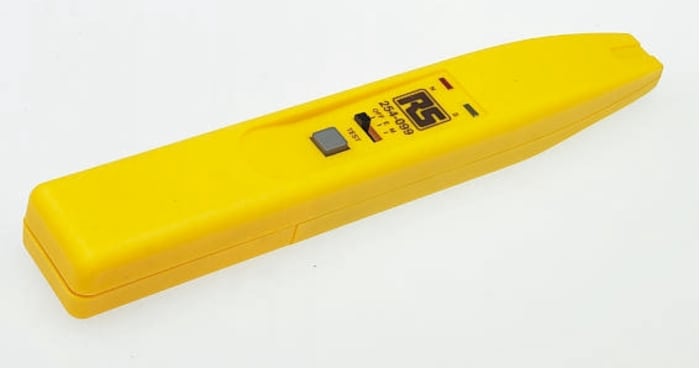Технически документи
Спецификации
Brand
MartindaleIndicator Type
Magnetic Field, Voltage
Magnetic Sensitivity
±10mT
Battery Type
9V
Audible Tone
Yes
Power Source
Battery
Safety Category
CAT III 1000 V, CAT IV 600 V
Weight
150g
Height
202mm
Length
32mm
Maximum Detection Voltage
600V ac
Minimum Detection Voltage
100V ac
Maximum Operating Temperature
+50°C
Safety Category Level
CAT III, CAT IV
Minimum Operating Temperature
0°C
Model Number p
TEK 200
Safety Category Voltage
600 V, 1000 V
Width
22mm
Model Number (p)
TEK 200
Детайли за продукта
Martindale TEK200 Non-Contact Voltage and Magnetic Field Detector
A non-contact voltage detector with the additional ability to detect magnetic fields, the TEK200 has audible warning and a self-test feature. Sleek in design and designed to be durable the detector can operate in an altitude of up to 2000m.
Suitable for permanent magnets and for indication of the polarity of machine windings, it has a magnetic sensitivity of ±10 mT. Indicating the operation of solenoid valves in pneumatic and hydraulic control equipment, testing relays or solenoids in a wide range of controls it has a wide variety of applications.
Features and Benefits:
• Senses AC voltages from 100 - 600V
• Detects electrical field
• Eliminates need for separate proving unit
• Self-testing
• Displays polarity of magnetic fields
• Powered by PP3 battery (RS Stock No. 394-9059)
How do magnetic field sensors and detectors work?
Magnetic field sensors are able to detect changes such as direction, strength or flux in a magnetic field. Magnetic field detectors are able to detect fields, such as unipolar, bipolar and electro-magnetic. There are many types of technology used for this and they all have different approaches. Some record the resistance, some have coils surrounding magnetic material, another measures fields against an internal magnet based response that runs through a fluxing set of parameters. Some devices contain switches, when the state of the switch is changed for example from open to closed, a magnetic field has been detected. The most commonly known technologies are Fluxgate, Hall Effect, Magnetoresistive, magnetoinductive and SQUID. (Superconducting quantum interference devices)

€ 60,05
€ 60,05 Всеки (ex VAT)
1
€ 60,05
€ 60,05 Всеки (ex VAT)
Информацията за складовите наличности временно не е налична.
1
Информацията за складовите наличности временно не е налична.

Технически документи
Спецификации
Brand
MartindaleIndicator Type
Magnetic Field, Voltage
Magnetic Sensitivity
±10mT
Battery Type
9V
Audible Tone
Yes
Power Source
Battery
Safety Category
CAT III 1000 V, CAT IV 600 V
Weight
150g
Height
202mm
Length
32mm
Maximum Detection Voltage
600V ac
Minimum Detection Voltage
100V ac
Maximum Operating Temperature
+50°C
Safety Category Level
CAT III, CAT IV
Minimum Operating Temperature
0°C
Model Number p
TEK 200
Safety Category Voltage
600 V, 1000 V
Width
22mm
Model Number (p)
TEK 200
Детайли за продукта
Martindale TEK200 Non-Contact Voltage and Magnetic Field Detector
A non-contact voltage detector with the additional ability to detect magnetic fields, the TEK200 has audible warning and a self-test feature. Sleek in design and designed to be durable the detector can operate in an altitude of up to 2000m.
Suitable for permanent magnets and for indication of the polarity of machine windings, it has a magnetic sensitivity of ±10 mT. Indicating the operation of solenoid valves in pneumatic and hydraulic control equipment, testing relays or solenoids in a wide range of controls it has a wide variety of applications.
Features and Benefits:
• Senses AC voltages from 100 - 600V
• Detects electrical field
• Eliminates need for separate proving unit
• Self-testing
• Displays polarity of magnetic fields
• Powered by PP3 battery (RS Stock No. 394-9059)
How do magnetic field sensors and detectors work?
Magnetic field sensors are able to detect changes such as direction, strength or flux in a magnetic field. Magnetic field detectors are able to detect fields, such as unipolar, bipolar and electro-magnetic. There are many types of technology used for this and they all have different approaches. Some record the resistance, some have coils surrounding magnetic material, another measures fields against an internal magnet based response that runs through a fluxing set of parameters. Some devices contain switches, when the state of the switch is changed for example from open to closed, a magnetic field has been detected. The most commonly known technologies are Fluxgate, Hall Effect, Magnetoresistive, magnetoinductive and SQUID. (Superconducting quantum interference devices)


